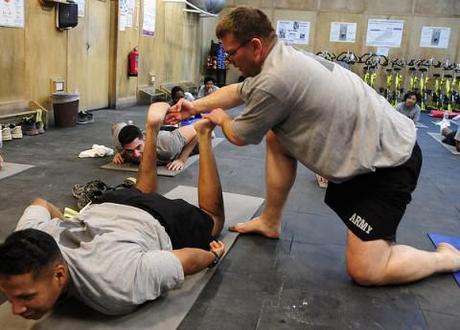
Yoga: Watch those hamstrings. Photo credit: The US Army, http://flic.kr/p/6rhFvb
Yoga may be bad for your health, according to a New York Times Magazine piece that has the got commentariat talking. Long associated with inner peace, gentle exercise and seriously bendy legs, yoga may actually be responsible for a host of serious injuries, including strokes, tearing of the retina and brain damage. Yes, we did just say tearing of the retina.
The medical community has been concerned about the dangers of yoga poses for several decades, reported William J. Broad for The New York Times, but the problem has grown worse due to its huge popularity: “There is now an abundance of studios where many teachers lack the deeper training necessary to recognize when students are headed toward injury.”
So should you stay away from yoga or is all the talk of retinal tearing and brain damage just plain old scare-mongering?
Yoga is not for everyone. Yoga teacher Glenn Black told The New York Times that “the vast majority of people” should stop doing yoga; Black himself underwent surgery for a back injury caused by two decades of bending and twisting. According to Black, yoga should only be practised by those who are already in good shape, not as part of a general class or to heal old injuries. This is due in part to the origins of yoga, reported the NYT: the original Indian practitioners were used to squatting and sitting cross-legged on an everyday basis; but now, yoga is the preserve of “urbanites who sit in chairs all day walk into a studio a couple of times a week and strain to twist themselves into ever-more-difficult postures despite their lack of flexibility and other physical problems”.
Examples of yoga injuries detailed in The New York Times include: Torn Achilles tendons from doing the downward-facing dog pose; a stroke suffered while doing the upward bow; ripped hamstrings. Ouch.
The New York Times hates yoga. The NYT piece is based on a book about the risks and rewards of yoga, wrote Paul Raeburn at the Knight Science Journalism Tracker: “The Times magazine editors, however, focused only on the risks; the excerpt says little about the rewards, except to claim that they are often overstated.” According to Raeburn, this is part of a pattern at the NYT, which “often seems both obsessed and confused about yoga, as I wrote in 2010 when the Times published five stories on yoga in one week”. Raeburn argued for a more balanced view: Yoga is neither a cure-all nor more potentially harmful than other sports.
It’s not just about the body. Newcomers to yoga may be disappointed that the central idea is not to develop a hot bod – the real message is spirituality, argued Lori Landau at Technorati: “Modifying our understanding of yoga to accept that it’s our thinking machinery that needs to be tweaked more than our bodies, can ironically, make yoga rewarding than ever – before you even move a muscle.”
Sell-out? “Has yoga lost its soul?” asked Justin Hakuta at The Huffington Post, pointing out that the practice has reached a level of “infamous popularity, mainstream accessibility and frantic commercialization in the West”. However, Hakuta argued that the strength of yoga lies in the variety of its forms, and that the sport can be adapted to suit different demographics: “Yoga has the opportunity to address an ever-increasing list of needs and tastes as teachers identify creative ways to apply the ancient practice to better suit the modern urban dweller.”

